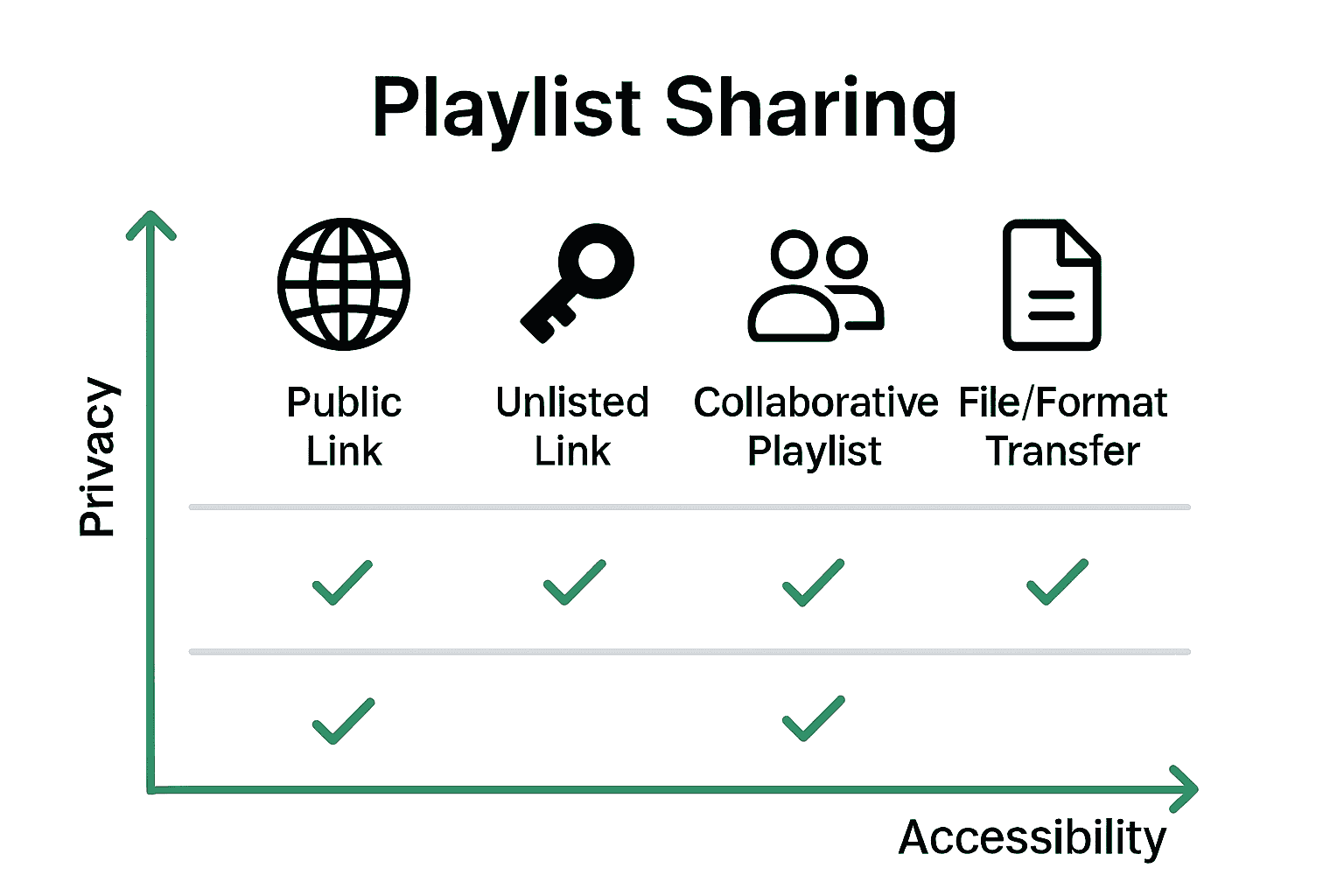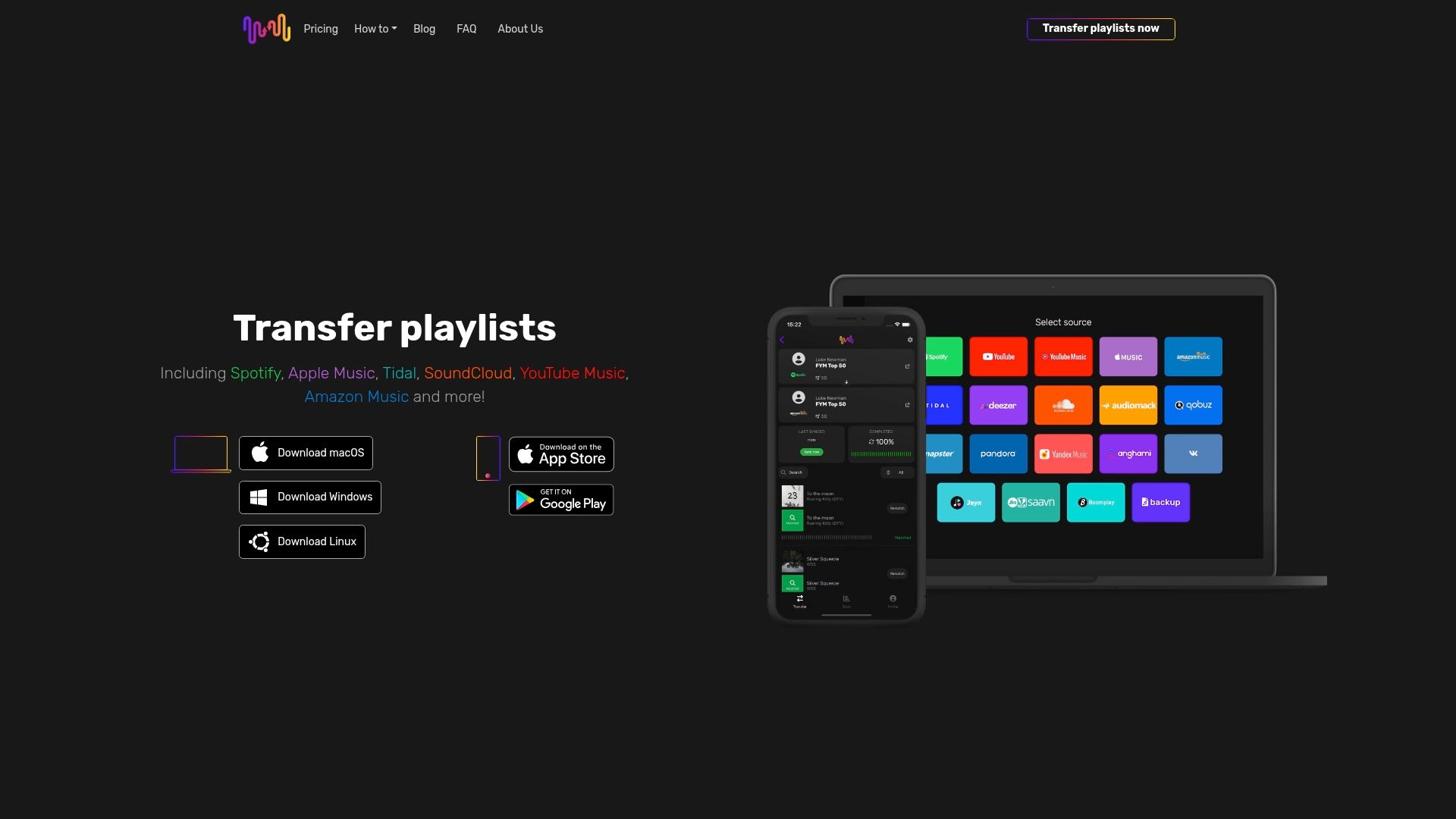More than 50 percent of music fans discover new songs through shared playlists. With digital listening on the rise, the way people connect and share their favorite tracks shapes musical trends and friendships worldwide. Playlist sharing is more than swapping songs. It creates bonds, sparks creativity, and helps listeners explore collections they might never find on their own.
Key Takeaways
| Point | Details |
|---|---|
| Purpose of Playlist Sharing | Enables music discovery, social connection, creative expression, and community building among users. |
| Types of Sharing Methods | Playlist sharing includes public links, unlisted links, collaborative playlists, and file format transfers to cater to user preferences. |
| Privacy and Security Concerns | Users should be aware of potential risks like access control, personal information protection, and copyright awareness when sharing playlists. |
| Common Pitfalls | Incompatible formats, incomplete track matching, and licensing restrictions pose significant challenges in cross-platform playlist sharing. |
Table of Contents
- Defining Playlist Sharing And Its Purpose
- Major Types Of Playlist Sharing Methods
- How Playlist Sharing Works Across Platforms
- Privacy, Security, And Legal Considerations
- Common Pitfalls And How To Avoid Them
Defining Playlist Sharing and Its Purpose
Playlist sharing has revolutionized how music enthusiasts discover, enjoy, and connect through their favorite tracks. Playlist sharing is the process of distributing a curated selection of music tracks across digital platforms, enabling users to broadcast their musical tastes and discover new sounds through others' compilations.
According to Wikipedia, a playlist represents a carefully curated list of audio files organized for sequential or shuffled playback. Modern streaming contexts have transformed this concept into a powerful social tool that goes beyond simple music listening. Key purposes of playlist sharing include:
- Music Discovery: Allowing listeners to explore new artists and genres through carefully crafted collections
- Social Connection: Enabling music fans to share personal soundtracks and emotional experiences
- Creative Expression: Providing a platform for individuals to showcase their musical curation skills
- Community Building: Creating shared listening experiences across different geographical locations
Playlist sharing transcends traditional music consumption by turning listening into an interactive, communal experience. It bridges the gap between personal music preferences and global musical exploration, giving users the ability to not just listen, but also communicate through meticulously selected musical sequences. Learn more about transferring playlists across platforms to maximize your sharing potential and musical connectivity.
Major Types of Playlist Sharing Methods
Playlist sharing has evolved into multiple sophisticated methods that cater to different user needs and platform capabilities. Digital sharing methods have transformed how music enthusiasts distribute and discover curated track collections across various digital environments.
According to Wikipedia, several markup and file-based playlist formats enable cross-platform and cross-device sharing. These standardized formats include:

- XSPF: An XML-based playlist format for universal music sharing
- ASX: Microsoft's Advanced Stream Redirector format
- SMIL: Synchronized Multimedia Integration Language
- WPL: Windows Media Player playlist format
As reported by Popular Science, streaming platforms typically offer two primary sharing mechanisms. Public Links allow anyone to access and enjoy the playlist, while Unlisted Links provide more privacy by restricting access to those with the specific URL. Some advanced platforms even support collaborative playlists, where multiple users can collectively edit and contribute tracks.
Explore seamless playlist transfers to understand how modern tools are breaking down barriers between different music streaming services, enabling more flexible and dynamic playlist sharing experiences.
Here's a comparison of key playlist sharing methods and their typical features:

| Sharing Method | Accessibility | Collaboration | Privacy Options |
|---|---|---|---|
| Public Link | Open to anyone | Usually no | Public |
| Unlisted Link | Link holders only | Sometimes | Unlisted/Hidden |
| Collaborative Playlist | Invited users only | Yes | Varies by platform |
| File/Format Transfer | Cross-platform users | No | Depends on file sharing |
How Playlist Sharing Works Across Platforms
Platform-specific playlist sharing transforms the way music lovers exchange their favorite tracks, with each streaming service offering unique mechanisms for distribution and collaboration. The complexity of sharing varies dramatically across different music platforms, creating a nuanced landscape for music enthusiasts.
According to Popular Science, platforms implement distinctly different sharing strategies. YouTube Music, for instance, allows users to set playlists as public or unlisted, with options for collaborative editing. Other services like Deezer and Tidal provide link-sharing capabilities, often enabling preview access even for non-subscribers.
The sharing process typically involves several key steps:
- Privacy Selection: Choosing between public, private, or unlisted playlist visibility
- Link Generation: Creating a unique URL that can be distributed
- Collaboration Settings: Determining whether other users can edit or just view
- Platform Compatibility: Ensuring the playlist can be accessed across different devices and services
Free Your Music: Ultra Simple Transfer of Playlists represents a solution to the intricate challenge of cross-platform playlist sharing. By bridging the gaps between different streaming services, these tools enable music fans to transcend traditional platform limitations, making playlist sharing more fluid and user-friendly than ever before.
Privacy, Security, and Legal Considerations
Digital playlist sharing introduces complex privacy and security challenges that require users to be mindful of potential risks and protective strategies. Understanding the nuanced landscape of digital music distribution is crucial for maintaining personal data safety and respecting intellectual property rights.
According to Wikipedia, playlist file formats like M3U and M3U8 can potentially expose security vulnerabilities. These plain-text file formats, while widely used for media sharing, have historically presented risks in media players such as VLC and iTunes. This underscores the importance of carefully managing and handling playlist files to prevent potential security breaches.
Key privacy and security considerations for playlist sharing include:
- Access Control: Limiting who can view or edit shared playlists
- Personal Information Protection: Avoiding oversharing personal music preferences
- Copyright Awareness: Respecting artist and platform usage rights
- Data Transmission Security: Using encrypted sharing methods
In enterprise environments, as noted by Microsoft Support, playlist sharing involves sophisticated permission management. Playlist owners can:
- Restrict resharing capabilities
- Control precise access levels
- Embed playlists within secure platforms
- Revoke access instantaneously if needed
Learn about seamless and secure playlist transfers to understand how modern tools prioritize user privacy while enabling smooth music sharing experiences.
Common Pitfalls and How to Avoid Them
Playlist sharing seems straightforward, but numerous technical and practical challenges can derail your music distribution efforts. Understanding these potential roadblocks is crucial for ensuring a smooth and enjoyable sharing experience across different platforms.
According to Popular Science, cross-platform sharing is notoriously complex due to platform-specific limitations. Different streaming services often use unique playlist formats that aren't universally compatible, creating significant barriers for music enthusiasts wanting to share their curated collections.
Common playlist sharing pitfalls include:
- Incompatible Formats: Different platforms use proprietary playlist structures
- Incomplete Track Matching: Some services fail to transfer exact tracks
- Licensing Restrictions: Regional music rights can block playlist imports
- Metadata Loss: Original playlist information might get stripped during transfer
Third-party solutions offer innovative workarounds. As Tune My Music highlights, specialized tools can generate cross-platform links that enable recipients to import playlists to their preferred service, ensuring they can play full tracks rather than limited previews. These platforms act as translation services, bridging the gaps between different streaming ecosystems.
Explore playlist transfer solutions to navigate the complex landscape of music sharing and overcome the most common digital distribution challenges.
Transform Your Playlist Sharing Experience—No More Limitations
Navigating the world of playlist sharing should be exciting and effortless, but the reality often feels much more complicated. You have carefully curated song lists, but you face barriers when moving them between streaming services or sharing them with friends who use different platforms. Sudden compatibility issues, lost tracks, locked privacy settings, and incomplete playlist transfers can quickly turn music sharing from a joyful activity into a frustrating hassle. If you have faced any of these pain points like incompatible formats, licensing restrictions, or metadata loss described in our complete user guide, you are not alone.

Take the stress out of playlist sharing and migration today with FreeYourMusic.com. Our powerful app preserves every detail—order, structure, and song accuracy—while you switch between Spotify, Apple Music, Tidal, YouTube Music, Amazon Music, and more. Stop letting platform barriers and hidden technicalities block your musical journey. Learn how you can seamlessly transfer your playlists and enjoy ultra-simple, worry-free migration across all major streaming services. Make the move now to keep your music collection safe and accessible, no matter where you listen.
Frequently Asked Questions
What is playlist sharing?
Playlist sharing is the process of distributing curated music tracks across digital platforms, enabling users to explore new sounds, connect with others, and express their musical tastes through shared playlists.
What are the main types of playlist sharing methods?
The primary methods of playlist sharing include public links, unlisted links, collaborative playlists, and file/format transfers. Each method varies in accessibility and privacy options.
How does playlist sharing work across different platforms?
Playlist sharing on various platforms involves selecting privacy settings, generating unique sharing links, and managing collaboration features. Different services have unique mechanisms, enhancing or limiting sharing capabilities depending on the platform.
What privacy and security considerations should I keep in mind while sharing playlists?
When sharing playlists, it's important to control access, protect personal information, respect copyright laws, and ensure data transmission security to mitigate risks associated with digital sharing.




